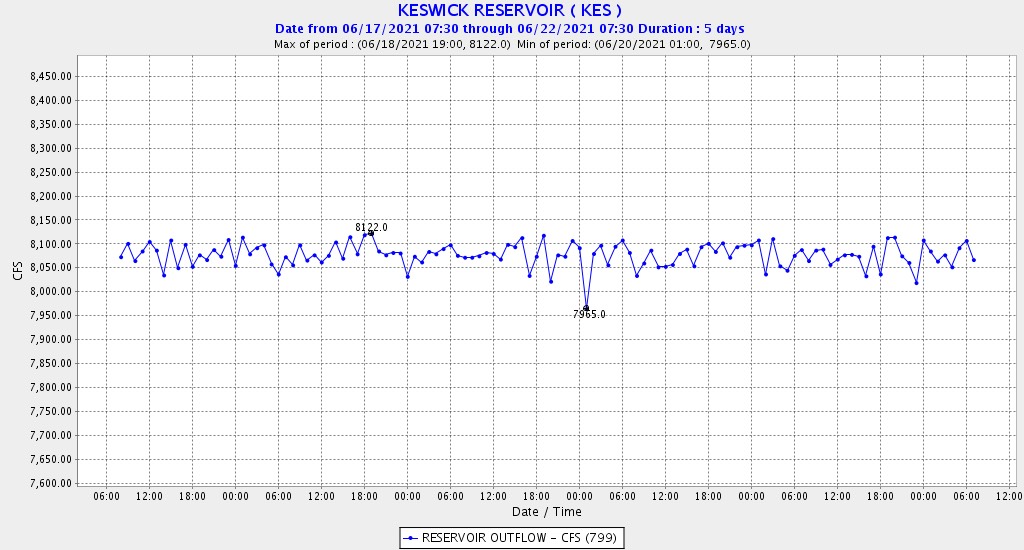Reclamation has begun its planned summer operation for winter-run salmon in this critically-dry summer of 2021. After delivering a lot of warm surface water from Shasta Reservoir to its downstream contractors this spring,1 Reclamation has now begun dipping into Shasta’s cold-water pool (Figures 1 and 2). Reclamation’s summer operation will encourage the holding salmon to spawn and, for a time, ensure the eggs can survive in the primary ten-mile spawning reach downstream to the mouth of Clear Creek (CCR). Reclamation’s plan would subsequently raise water temperatures later in summer, after peak spawning and embryo development have occurred.
In first five days (June 17-22) of the new operation, Reclamation met its target temperature. It has released about 8000 cfs of 53ºF water from Keswick Dam to the Sacramento River near Redding (Figure 3). It achieved the target by blending hydropower-peaking flows from Shasta and Whiskeytown dams in Keswick Reservoir, and then releasing the blended water to the Sacramento River below Keswick Dam. During this time, Reclamation released an average of 6500 cfs from Shasta Dam at 50-51ºF, and an average of 1200 cfs at 53ºF through the Spring Creek Powerhouse (SPP) from Whiskeytown, into Keswick Reservoir.
This operation is not sustainable over the summer. It uses more of the cold-water-pool volume than is necessary to maintain temperature control. It sacrifices the cold-water pool in order to continue power peaking and to maintain relatively high downstream irrigation deliveries. Considering all of the factors pushing Keswick release temperatures higher over the summer, there will not be enough cold water by the end of the summer to protect salmon.
High Shasta Dam releases in the afternoon and evening to meet peak power demands pull more water from the warmer surface waters of the reservoir (Figures 4-6). This then requires blending with cold-water releases to keep Keswick water cooler. A similar situation occurs with the Whiskeytown releases (Figure 7-8). In addition, water in Whiskeytown becomes progressively warmer over the summer and requires an ever-increasing amount of Shasta’s cold-water pool to cool that water. Atmospheric heating combines with heating of water from Shasta during power-peaking operations to further affect Keswick Reservoir’s water temperatures (Figures 9 and 10).
Reclamation’s current high demands on Shasta’s cold-water pool will thus require reverting in late summer to warmer water releases. This will lower the survival of late summer spawners and their eggs. It will also leave little cold water for fall-run salmon in October and November. Reclamation is willing to accept these trade-offs to make relatively high power and irrigation deliveries.
To reduce the loss of winter-run (and fall-run) salmon this summer, CSPA and two other organizations submitted an alternative Temperature Management Plan (CSPA TMP) to the State Water Board on May 23, 2021. The CSPA TMP would provide better summer water temperatures and salmon egg survival. The CSPA TMP, comprised of a transmittal letter, descriptive elements and spreadsheet, proposes a release of just 5000 cfs of 52-53ºF water from Shasta Dam’s gates and minimal warmer water inputs from Whiskeytown/Trinity. The CSPA TMP proposes a 5000 cfs release of 53-54ºF water from Keswick, with less daily peaking power production to limit withdrawals of warm water from the surface of Shasta reservoir.
The CSPA TMP would minimize impacts to the salmon and save approximately 200,000 acre-feet of Shasta storage. It would also save 200,000 acre-feet of Trinity storage. It would greatly reduce power production from five system powerhouses, though power generation capacity would still be available for periods of extreme power demand.
Above all, the CSPA TMP would reduce water supply deliveries in the Sacramento Valley and eliminate water transfers from Shasta in the summer and fall. Reclamation is willing to sacrifice a substantial portion of the Sacramento River’s salmon in order to prioritize agricultural water deliveries. The CSPA TMP prioritizes a system operation that will reasonably protect salmon, and allocates water supply based on the water that is available within the constraints of that operation.

Figure 1. Shasta Dam infrastructure and operations, and cold-water pool conditions, during the June 17-22 period. Note water release from PRG gates, drawing from the layer of water less than 48ºF, and release from middle gates of water that is 70ºF or warmer. The combined flow release from the Temperature Control Device was 6000-7000 cfs of 51-52ºF water.

Figure 2. Water temperatures (ºF) recorded at Sacramento River gages from Shasta Dam (SHD, RM 310) downstream to Red Bluff (RDB, RM 240) 5/1-6/16, 2021. Keswick Dam (KWK, RM 300) is the release point from the Shasta Dam complex to the Sacramento River. Spawning area is ten miles downstream of Keswick to mouth of Clear Creek (CCR). Red arrow points out yellow highlight of recently changed operation to benefit salmon spawning.

Figure 3. Water temperatures (daily average. ºF) from Shasta Dam release (SHD) and from Keswick Dam (KWK, RM 300) downstream through primary winter-run spawning reach to gage located just upstream from mouth of Clear Clear Creek (CCR, RM 290). Note: the difference between SHD and KWK release temperatures are due to inputs to Keswick Reservoir from Whiskeytown from Whiskeytown Reservoir through the Spring Creek Powerhouse (SPP) and to internal heating and mixing in Keswick Reservoir. The compliance control point gage is SAC, located at the midpoint of the ten-mile spawning reach. The compliance point target was 55ºF during the period.

Figure 4. Water temperature (ºF) at gage SHD immediately downstream of Shasta Dam, June 17-22.

Figure 5. Shasta Reservoir hourly outflow (cfs), June 17-22.

Figure 6. Water temperature (ºF) at gage SHD immediately downstream of Shasta Dam, June 17-22.

Figure 7. Hourly measued water release (cfs) from Whiskeytown.

Figure 8. Water temperature (ºF) at gage SPP immediately downstream of Spring Creek Powerhouse June17-22.

Figure 9. Keswick Reservoir hourly outflow (cfs), June17-22.

Figure 10. Water temperature (ºF) at gage KWK immediately downstream of Keswick Dam, June17-22.



















